MICROSCOPE
MAKER:Charles Baker Company
MODEL:'Nelson-Curties No 1a' or 'Nelson-Curties No 1A'
c.1900
SIGNED: 'BAKER, 244, HIGH HOLBORN, LONDON'
SIGNED ON THE SIDE OF THE TOP OF THE UPPER DRAW TUBE:'AGENTS, SHARLAND & CO, AUCKLAND
SERIAL(?) NUMBER: 322
Please Click On Any Picture for a Larger Version
DESCRIPTION: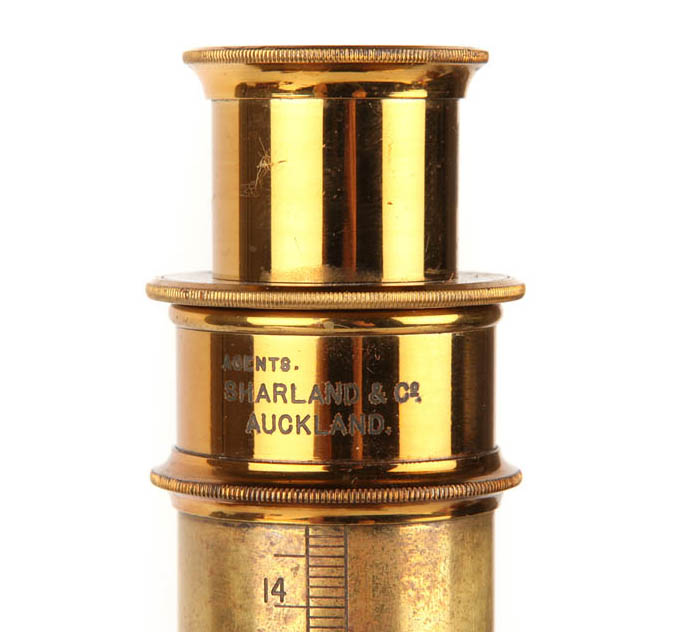
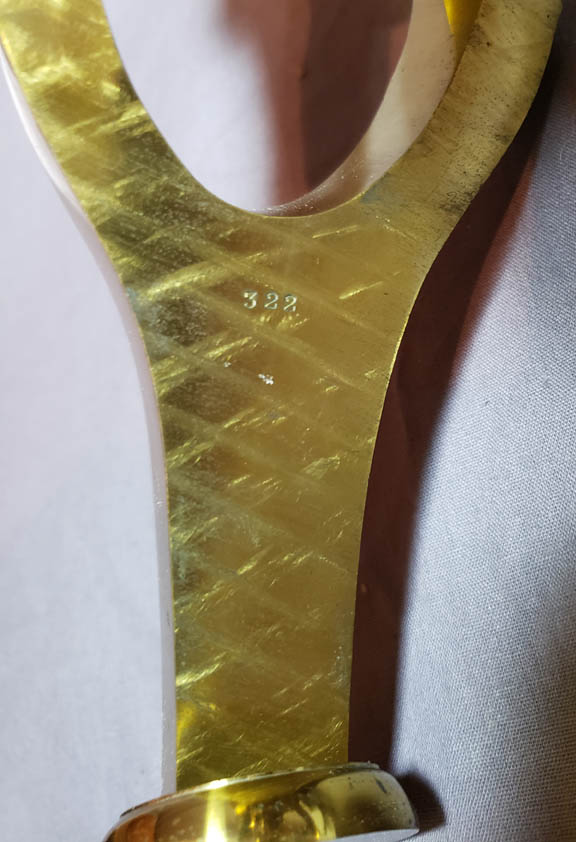 This is a large, heavy, and well made microscope. It is signed on the rear leg of the tripod foot ‘BAKER 244 HIGH HOLBORN LONDON’, with the number 322 stamped into the back of the tripod rear leg. The top draw tube is signed: 'AGENTS, SHARLAND & Co, AUCKLAND'. It stands on a massive tripod base with a large round padded rear leg in the back and two rectangular pads on the front legs with slots towards the front for potential use in fixing the microscope to a surface. The spread of the legs (outside edge to outside edge) is 11 inches(27 3/4 cm)right to left and 9 11/16 inches (23 cm) from each front pad to to the back pad. It is 6 1/2 inches from the table surface to the middle of the axis of inclination. At the top of the tripod base are large trunnions that run through the limb just above the stage. A large clamping lever allows fixing the microscope in any position from vertical to horizontal. There is a round hole on the right and left side of the limb which would accept accessories like a stage forceps or side reflector. Under the stage of the microscope is a large plano-concave mirror supported only on one side; that support is further held on an articulated arm. It comes in its original heavy mahogany fitted case. The microscope itself weights about 19.5 pounds (about 9 KG).
This is a large, heavy, and well made microscope. It is signed on the rear leg of the tripod foot ‘BAKER 244 HIGH HOLBORN LONDON’, with the number 322 stamped into the back of the tripod rear leg. The top draw tube is signed: 'AGENTS, SHARLAND & Co, AUCKLAND'. It stands on a massive tripod base with a large round padded rear leg in the back and two rectangular pads on the front legs with slots towards the front for potential use in fixing the microscope to a surface. The spread of the legs (outside edge to outside edge) is 11 inches(27 3/4 cm)right to left and 9 11/16 inches (23 cm) from each front pad to to the back pad. It is 6 1/2 inches from the table surface to the middle of the axis of inclination. At the top of the tripod base are large trunnions that run through the limb just above the stage. A large clamping lever allows fixing the microscope in any position from vertical to horizontal. There is a round hole on the right and left side of the limb which would accept accessories like a stage forceps or side reflector. Under the stage of the microscope is a large plano-concave mirror supported only on one side; that support is further held on an articulated arm. It comes in its original heavy mahogany fitted case. The microscope itself weights about 19.5 pounds (about 9 KG).
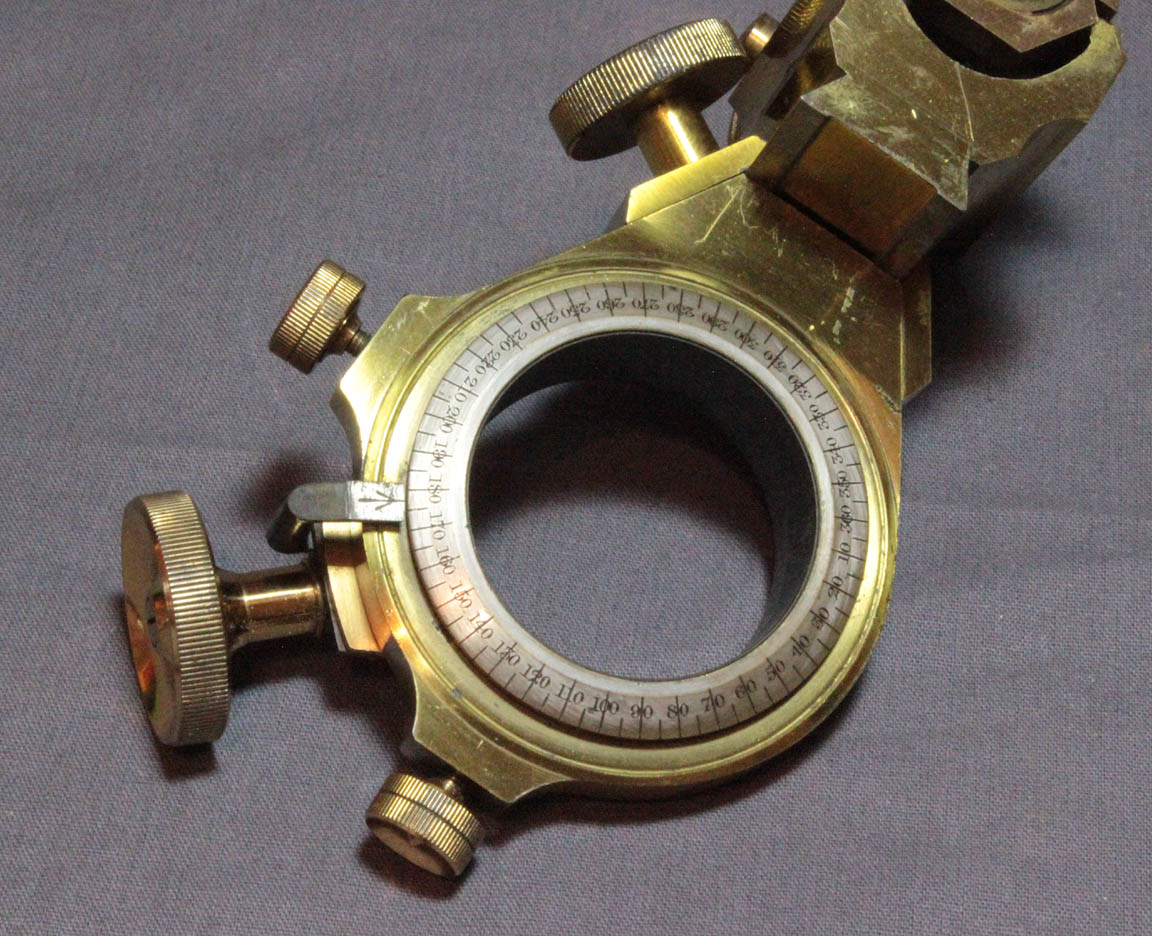
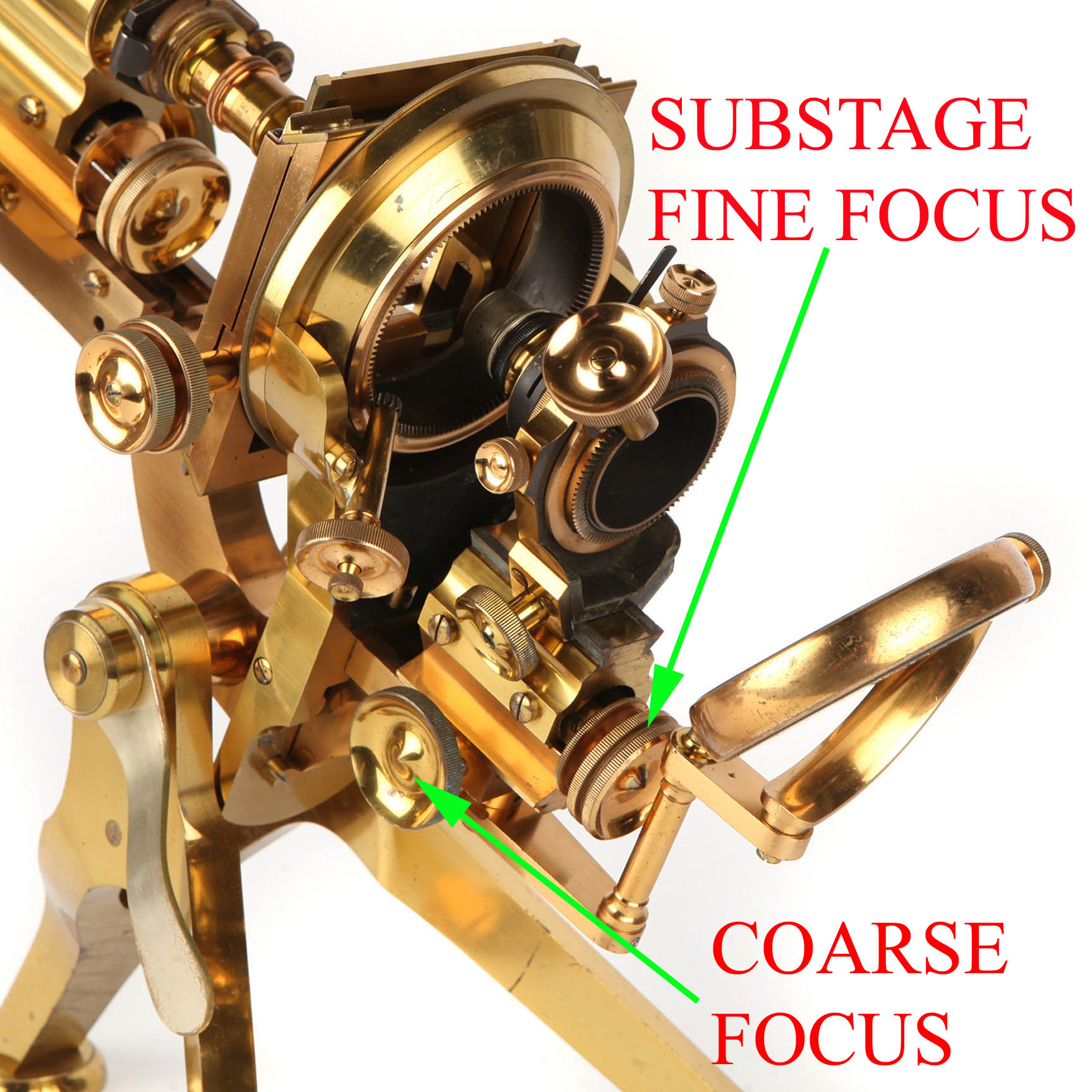 The substage collar is on a dovetail mount which slides up and down on the substage support and can be tightened in position with a friction positioning adjustment. This allows customized positioning for various accessories of different lengths.
The substage collar is on a dovetail mount which slides up and down on the substage support and can be tightened in position with a friction positioning adjustment. This allows customized positioning for various accessories of different lengths. The substage has diagonal rack and pinion focusing coarse adjustment; fine focusing of the substage** is via a knurled knob at the bottom end of the substage tailpiece. The substage collar has X-Y centering adjustment and can be rotated via a rack and pinion crown gear arrangement. The substage collar has an engraved silvered scale to indicate rotation.
**The fine focus control of the substage, was first suggested by E.M. Nelson in the last quarter of the 19th century. It was a feature offered to satisfy the need of those who sought to resolve the most minute detail, usually while examining subjects like diatoms with extremely fine markings and with high power. It facilitated so-called 'Nelsonian' or 'Critical' Illumination where one needs to precisely focus an illuminating source like a ribbon filament of an electric light or a thin wick of an oil lamp on the subject on the slide.
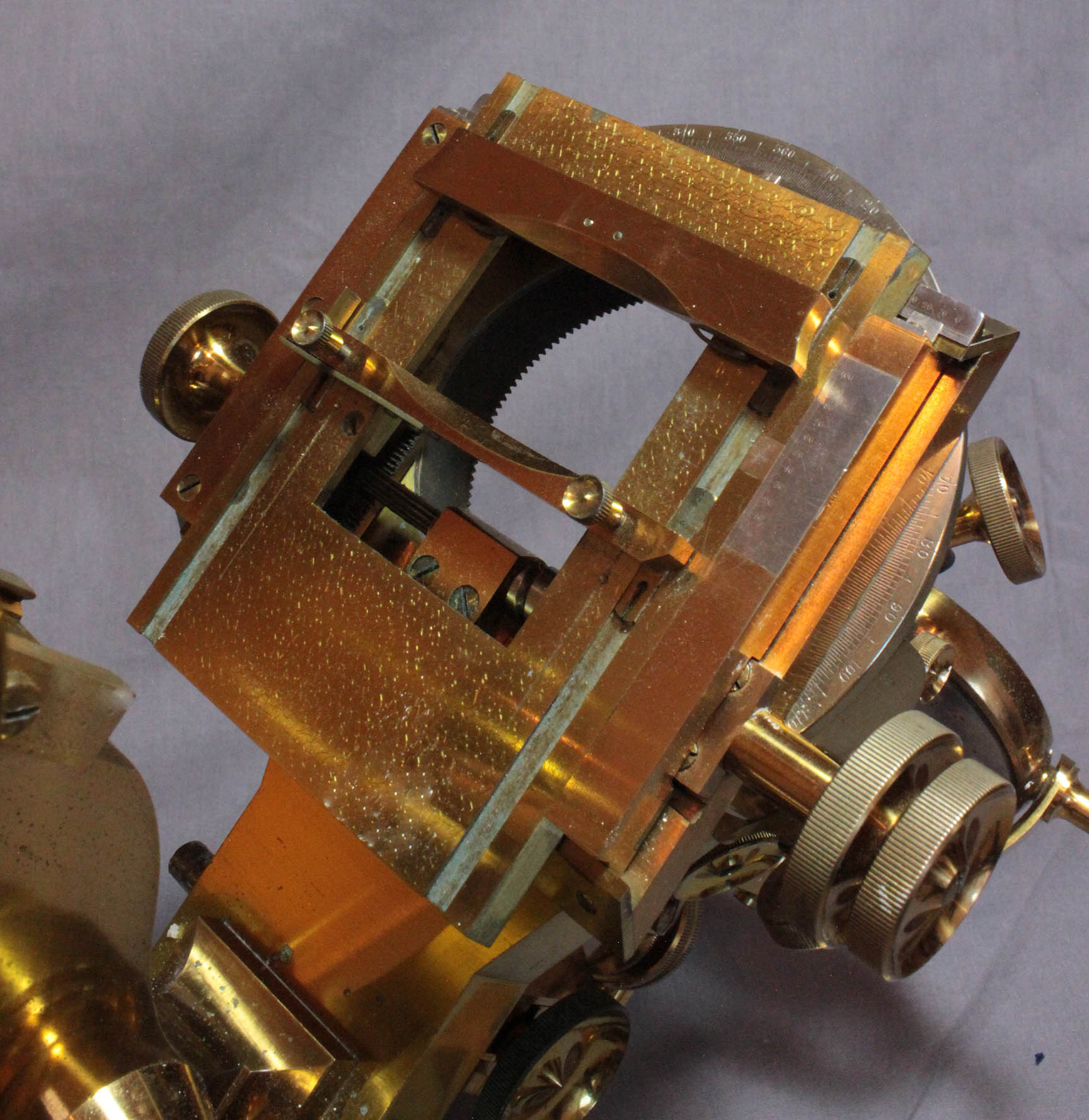 The large mechanical stage is constructed with controls and mechanisms like Powell & Lealand's No 1. It has full X-Y control via concentric knurled knobs to the side on the right, with only a single knob on the left which, like the smaller knob on the right controls the Y-axis. The Nickel scales on the stage indicate the position of the X or Y motion, allowing the user to find a particular spot on a slide in the future. The stage can travel 1 and ⅛ inches in both the X and Y direction. The usable surface of the stage measures 3 and ⅜ inches in the right to left dimension and 4 and ⅜ inches in the front to back dimension. The scales are located differently than on the Powell & Lealand stand. For right-left(X-axis) movement there are two scales, one to the right front and one to the left front of the stage; the left side is used to indicate the slide position when it is moved to the right from the mid-position, the right is used when the stage is moved to the left. The X-axis movement is via a cam and follower mechanism, just like Powell & Lealand stands. The Y-axis movement, again, like P & L, is via rack and pinion. Below is a large bevel gear mechanism to rotate the stage again like Powell & Lealand's. A finely engraved, and relatively thick solid nickel(?) scale plate runs around the top edge of the round part of the stage, with an indicating arrow attached to the rotating stage. The design of this stage, and the angled control for stage rotation, which is permanently engaged, is strikingly similar to the mechanism of the Powell and Lealand No 1 stand of the same era. The design of the rotation plate is also almost identical to the P & L design; one wonders if Charles Perry, formerly of Powell and Lealand, but by then working for Baker, had a lot to do with the design and construction of this stage, as he apparently did when he worked for P & L. Two large slide rests on the top of the stage run in dovetail slots with one having springs to rest against the slide. The stage rotation knob sits at an angle under the stage and has a smaller knob on its center, which acts as a clutch, and can be used to increase the tension on this control or, if tightened completely, lock the stage rotation at an desired location. When the locking knob is loosened,even with the pinion permanently engaged, the stage is easily rotated manually, but will stay in the position it is left in. There are no stage-centering controls, and this is why the stand came with a Beck quick-change nosepiece centering system for objectives.
The large mechanical stage is constructed with controls and mechanisms like Powell & Lealand's No 1. It has full X-Y control via concentric knurled knobs to the side on the right, with only a single knob on the left which, like the smaller knob on the right controls the Y-axis. The Nickel scales on the stage indicate the position of the X or Y motion, allowing the user to find a particular spot on a slide in the future. The stage can travel 1 and ⅛ inches in both the X and Y direction. The usable surface of the stage measures 3 and ⅜ inches in the right to left dimension and 4 and ⅜ inches in the front to back dimension. The scales are located differently than on the Powell & Lealand stand. For right-left(X-axis) movement there are two scales, one to the right front and one to the left front of the stage; the left side is used to indicate the slide position when it is moved to the right from the mid-position, the right is used when the stage is moved to the left. The X-axis movement is via a cam and follower mechanism, just like Powell & Lealand stands. The Y-axis movement, again, like P & L, is via rack and pinion. Below is a large bevel gear mechanism to rotate the stage again like Powell & Lealand's. A finely engraved, and relatively thick solid nickel(?) scale plate runs around the top edge of the round part of the stage, with an indicating arrow attached to the rotating stage. The design of this stage, and the angled control for stage rotation, which is permanently engaged, is strikingly similar to the mechanism of the Powell and Lealand No 1 stand of the same era. The design of the rotation plate is also almost identical to the P & L design; one wonders if Charles Perry, formerly of Powell and Lealand, but by then working for Baker, had a lot to do with the design and construction of this stage, as he apparently did when he worked for P & L. Two large slide rests on the top of the stage run in dovetail slots with one having springs to rest against the slide. The stage rotation knob sits at an angle under the stage and has a smaller knob on its center, which acts as a clutch, and can be used to increase the tension on this control or, if tightened completely, lock the stage rotation at an desired location. When the locking knob is loosened,even with the pinion permanently engaged, the stage is easily rotated manually, but will stay in the position it is left in. There are no stage-centering controls, and this is why the stand came with a Beck quick-change nosepiece centering system for objectives.
At the top of the limb are the large coarse focusing knobs with the fine focus knob below, projecting down towards the stage. The fine focusing knob acts only on the optical tube, as its mechanism is carried on the main focusing slide moved by the coarse adjustment.

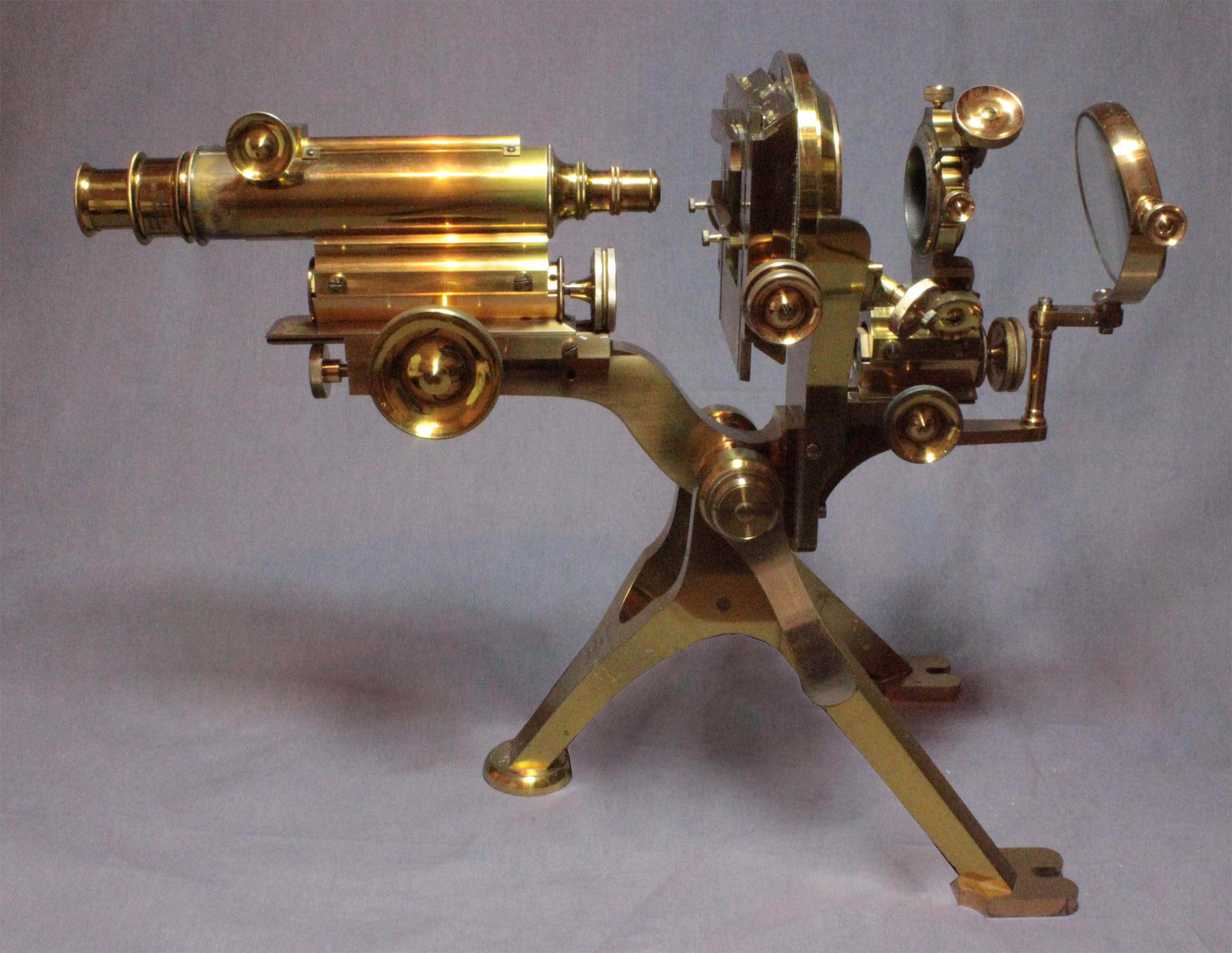 The body tube has two draw tubes, the top most one is a pull draw tube and the lower one is a geared (or mechanical) draw tube, controlled by rack and pinion; both draw tubes are calibrated. In addition, there is a fixed tube that can be used in place of the top draw tube screwing in from above to the geared draw tube after the other top draw tube collar is removed.
The body tube has two draw tubes, the top most one is a pull draw tube and the lower one is a geared (or mechanical) draw tube, controlled by rack and pinion; both draw tubes are calibrated. In addition, there is a fixed tube that can be used in place of the top draw tube screwing in from above to the geared draw tube after the other top draw tube collar is removed.
The two front foot slots and a knob at the top of the limb may be used to provide three anchor points for photography while the microscope is in the horizontal position.
ACCESSORIES:
The microscope comes with a number of fine accessories including eight Zeiss objectives, five Baker
objectives, four Watson eyepieces and one Zeiss eyepiece, a Beck darkground condenser, an achromatic condenser with filter holder, a Watson high power condenser, a set of condenser stops in a brass can, a nosepiece analyzer in can, a nosepiece iris (Davis shutter), a Beck quick-change and centering device for objectives in case, and a large Swift-type stand (bench) condenser (unsigned). Baker commonly sold objectives and eyepieces by other makers, particularly by Gundlach, Gundlach's successor Seibert, and Carl Zeiss. The majority of the Baker
objectives are actually of German manufacture by Gundlach or Siebert (Gundlach's successor).
The nine objectives not signed by Baker (all for 250mm tube length) include:
- Zeiss Homog.Imm 2.0mm Apert 1.4
- Zeiss a*
- Zeiss 4.0mm Apert 0.95
- Zeiss Apo 6mm Apert 0.95
- Zeiss Apo 8.0mm Apert 0.65
- Zeiss Apo 12.0mm Apert 0.65
- Zeiss E
- Zeiss Apo 24mm Apert 0.3
- Crouch Multiple 1-5
The five Baker
objectives include:
- Baker Agent 3"
No 00 Seibert
- Baker Agent 1"
No 1 Gundlach
- Baker Agent ½"
No 1 Seibert
- Baker ------ ¼"
------
- Baker Agent ⅛"
No V Seibert
The 5 eyepieces include:
- Watson Holos x5 eyepiece
- Watson Holos x8 eyepiece
- Watson Holos x10 eyepiece
- Watson Holos x14 eyepiece
- Zeiss 27e Compens-Ocular
The condensers and related parts include:
- Unsigned condenser housing. The optical element is signed '1/4 inch'.
- Watson condenser housing into which can fit a R & J Beck 7mm condenser (NA 1.00), or a Watson Holos oil condenser (NA 1.30).
- Large Abbe-type condenser with removeable top element.
- Beck darkfield condenser n.a. 1.25 – 1.45 rated for slides of 0.04 inch(1 mm) thickness
- A large Nicol-prism polarizer.
- There are two sets of stops and oblique illumination inserts.
CONDITION AND RARITY:
Cosmetically the microscope, case and accessories are in very good original condition. The lacquer is very good with little or no wear and only very small areas of lacquer loss, tarnish or verdigris. The silvered scale for the substage rotation is well preserved. The other nickel(?) scales are in excellent condition. Mechanically the microscope has no issues. Optically everything works well except for two of the Zeiss apo objectives that have crystallized lenses; the flat side of the mirror has some spotting, the concave side is clear.
The Nelson No 1a is one of the rarest of the large late Victorian microscopes. Thanks to Dr Joe Zeligs, we are aware of only three other examples sold in recent years. One sold at the ‘Arthur Frank collection’ auction at Sotheby’s on March 25, 1986, and another one sold on Ebay back in 2007. Both of these are less complete, and with fewer features than the model shown on this web page. Another fine example was sold at Flints auctions in November of 2021, and is the only known example with both monocular and binocular tubes. That example had a replaced inclination tightening arm. Surprisingly, there are no examples of this microscope in any of the main museums or public collections including the Golub collection, the RMS collection, the Science Museum of London, the Billings Collection, The Smithsonian, or the Moody collection.
HISTORY OF THE BAKER NELSON-CURTIES NO 1:
E. M. Nelson was a very influential and respected microscopist in the late 19th and early 20th century. He developed a method of illuminating slides called 'critical' or 'Nelsonian' illumination. To use this technique easily, focusing of the substage needed to be precise, and for this reason he suggested fine focus be added to the coarse focus then common on the substage carrying the condenser. He apparently approached Lee Curties, then running the Baker firm for help in constructing a microscope to his specifications. Not only did this incorporate fine focus for the substage, but also changed the traditional position of fine focusing from above the limb to below it. This was done to reduce strain on the microscope when fine focusing was controlled by pulleys during photogrpahy. Curties also positioned the fine focus for the substage at the bottom of the tailpiece. The first model was simply referred to as the 'Large Nelson Model' but later a larger version was produced. Once the larger model, called the 'Nelson-Curties No 1' was being offered, the original 'large' model was called the Nelson-Curties No 2, and this continued until these models were no longer offered. The Nelson models incorporated double draw tubes to allow greater flexibility in selection of objectives designed for different tube lengths. In addition, the lower of the two draw tubes had rack and pinion adjustment to allow it to compensate for the finer changes needed with high power objectives when the thickness of cover glasses varied.
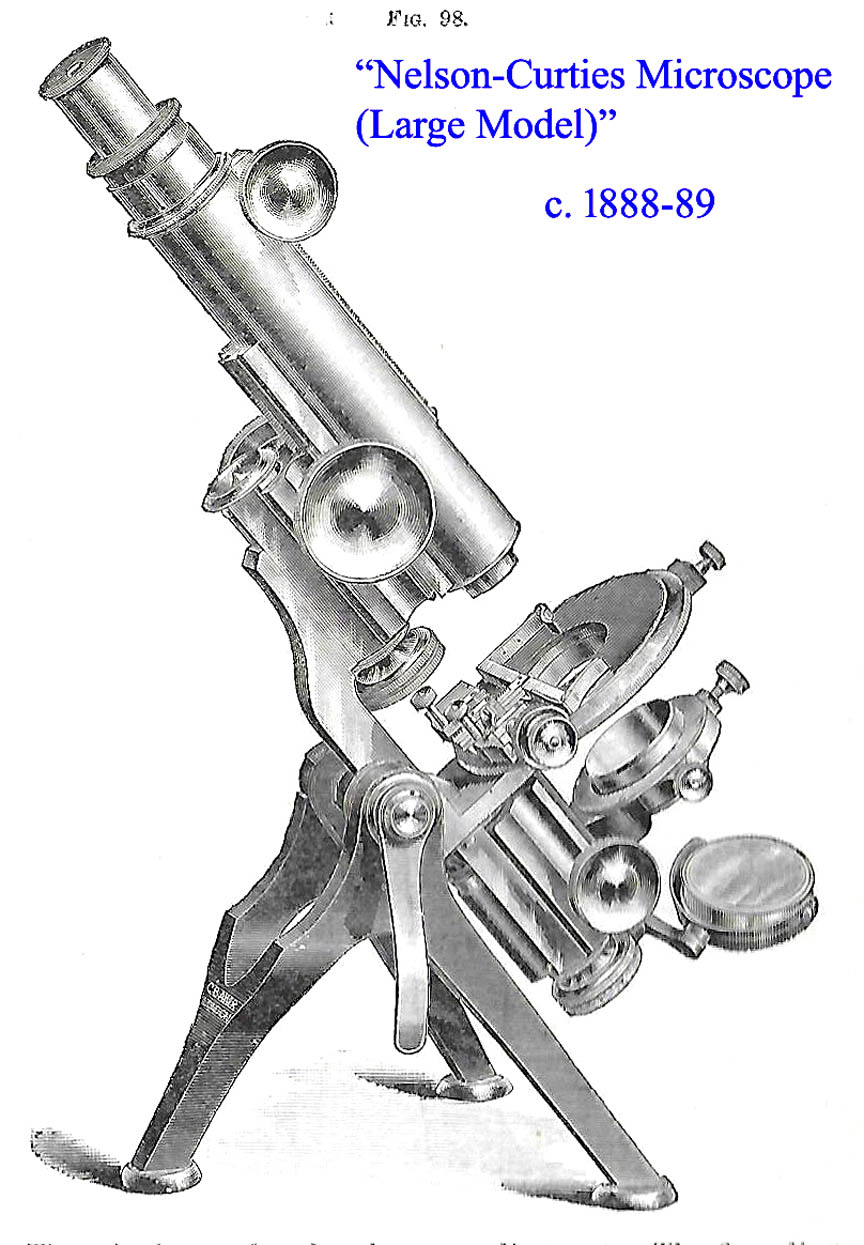 In 1888, the first versions of what came to be known as the 'Nelson' Model Microscopes by the Baker company were described. This stand, later to be called the 'Nelson-Curties No. 2'*, or simply the 'Nelson Model', is shown to the left, and was, for a short time, the major 'large' stand for the Baker company. This early version of the No. 2. was referred to in the JRMS as the 'Nelson-Curties (Large Model)'.
It was stated to be specifically designed to work with the new Zeiss Apochromats. That Nelson model was first reported only in written form in the JRMS of 1888 on page 691 and was subsequently first pictured in the JRMS of 1889 page 801, which is the illustration shown to the left.
The microscope, differed from the later number 2, but had several features later to be seen mainly in the No 1. The three most important differences were that the standard features included: (1) a concentrically controlled Mayall-type mechanical stage instead of the two separate controls seen on later models, (2)a substage fine adjustment, and (3)geared rotation to the substage. Later on these features were not standard on the No 2, and eventually, not even standard on the No 1.
In 1888, the first versions of what came to be known as the 'Nelson' Model Microscopes by the Baker company were described. This stand, later to be called the 'Nelson-Curties No. 2'*, or simply the 'Nelson Model', is shown to the left, and was, for a short time, the major 'large' stand for the Baker company. This early version of the No. 2. was referred to in the JRMS as the 'Nelson-Curties (Large Model)'.
It was stated to be specifically designed to work with the new Zeiss Apochromats. That Nelson model was first reported only in written form in the JRMS of 1888 on page 691 and was subsequently first pictured in the JRMS of 1889 page 801, which is the illustration shown to the left.
The microscope, differed from the later number 2, but had several features later to be seen mainly in the No 1. The three most important differences were that the standard features included: (1) a concentrically controlled Mayall-type mechanical stage instead of the two separate controls seen on later models, (2)a substage fine adjustment, and (3)geared rotation to the substage. Later on these features were not standard on the No 2, and eventually, not even standard on the No 1.
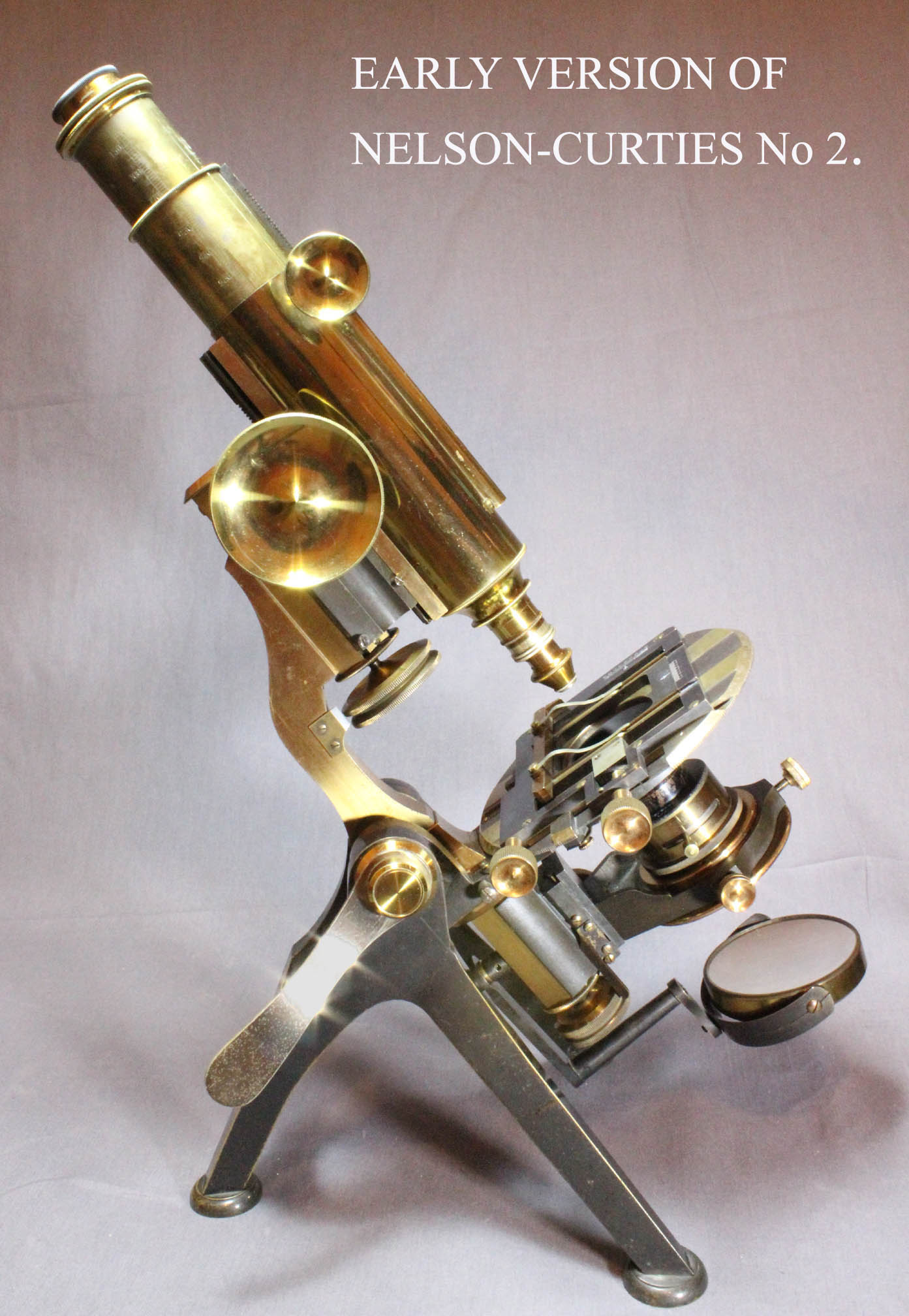 An example of an early form of the No 2, slightly later than the original, featuring the geared rotation and fine focus to the substage, is shown to the left, but by the time it was made, circa 1895, the mechanical stage controls were not concentric; this form of mechanical stage would be the standard type of stage for Nelson No 2 for the next two decades. As to the substage, still with geared rotation on the model to the left, this feature for substage rotation was also eliminated for the No 2 by 1898, when it was not even listed as an option.
An example of an early form of the No 2, slightly later than the original, featuring the geared rotation and fine focus to the substage, is shown to the left, but by the time it was made, circa 1895, the mechanical stage controls were not concentric; this form of mechanical stage would be the standard type of stage for Nelson No 2 for the next two decades. As to the substage, still with geared rotation on the model to the left, this feature for substage rotation was also eliminated for the No 2 by 1898, when it was not even listed as an option.
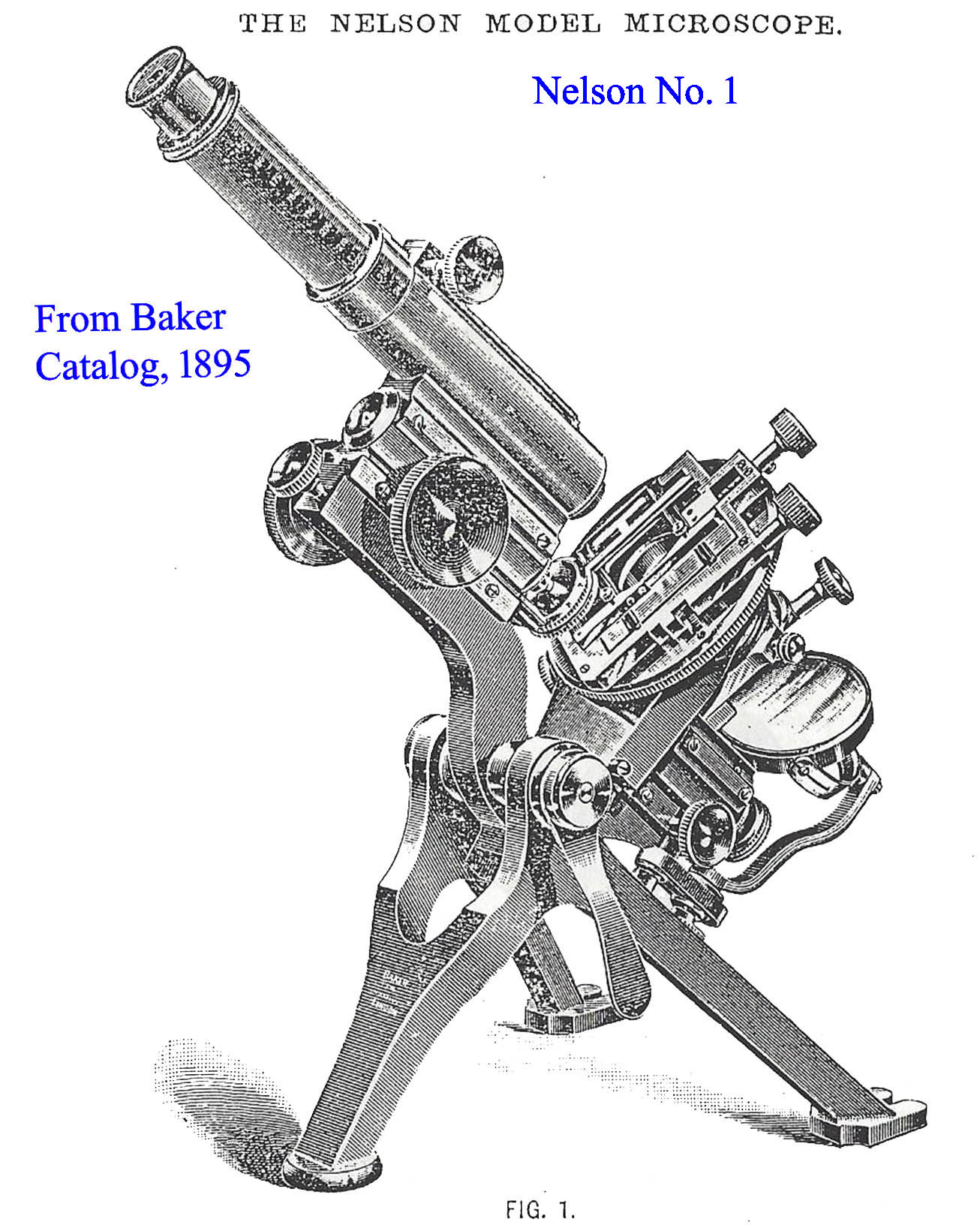 By 1892 a larger version, the 'New Microscope' or 'Nelson Model No. 1' a larger version of the Nelson-Curties design, became the 'No. 1' Stand, and the original 'Large' Nelson-Curties became the 'No 2'. The No 1 stand was usually shown in illustrations to have a rack and pinion rotation to both the stage and substage. The mirror support was double jointed, and the substage fine focus was standard. Most importantly, this was a much thicker, larger, and heavier stand. For the reader's interest, see the Nelson No 1 and No 2 Microscope Comparison page. Unlike earlier versions, now called the No 2's, the limb of the new No. 1 angles inward towards the stage, away from the inclination joint, whereas in the No 2, the limb continues straight from the inclination joint and at its top end, curves inward to meet the optical tube. The image to the left shows the earlier version of the model featured above at the top of this web page.
By 1892 a larger version, the 'New Microscope' or 'Nelson Model No. 1' a larger version of the Nelson-Curties design, became the 'No. 1' Stand, and the original 'Large' Nelson-Curties became the 'No 2'. The No 1 stand was usually shown in illustrations to have a rack and pinion rotation to both the stage and substage. The mirror support was double jointed, and the substage fine focus was standard. Most importantly, this was a much thicker, larger, and heavier stand. For the reader's interest, see the Nelson No 1 and No 2 Microscope Comparison page. Unlike earlier versions, now called the No 2's, the limb of the new No. 1 angles inward towards the stage, away from the inclination joint, whereas in the No 2, the limb continues straight from the inclination joint and at its top end, curves inward to meet the optical tube. The image to the left shows the earlier version of the model featured above at the top of this web page.
The 1895 No 1 was pictured in the catalog with two separate controls for the mechanical stage, but figure 2 showed it could be fitted with a Mayall stage with concentric controls, like the original No 2. Starting in 1896 the catalogs show concentric controls of Baker's own design, not a Mayall stage, and this model was renamed the No 1a-the model shown at the top of this web page. A bit more expensive(£35), it was termed the No 1a while the version with two separate stage controls, using the same mechanical stage as the No 2, was simply the No 1(£30). In later years, the substage fine focus was no longer a standard feature for the No 1, similar to what happened earlier with the No 2. The splay of the foot on the huge number 1 was noted in the catalog to be 11 x 9 inches (compared to 7 x 7.5 inches for the No 2).
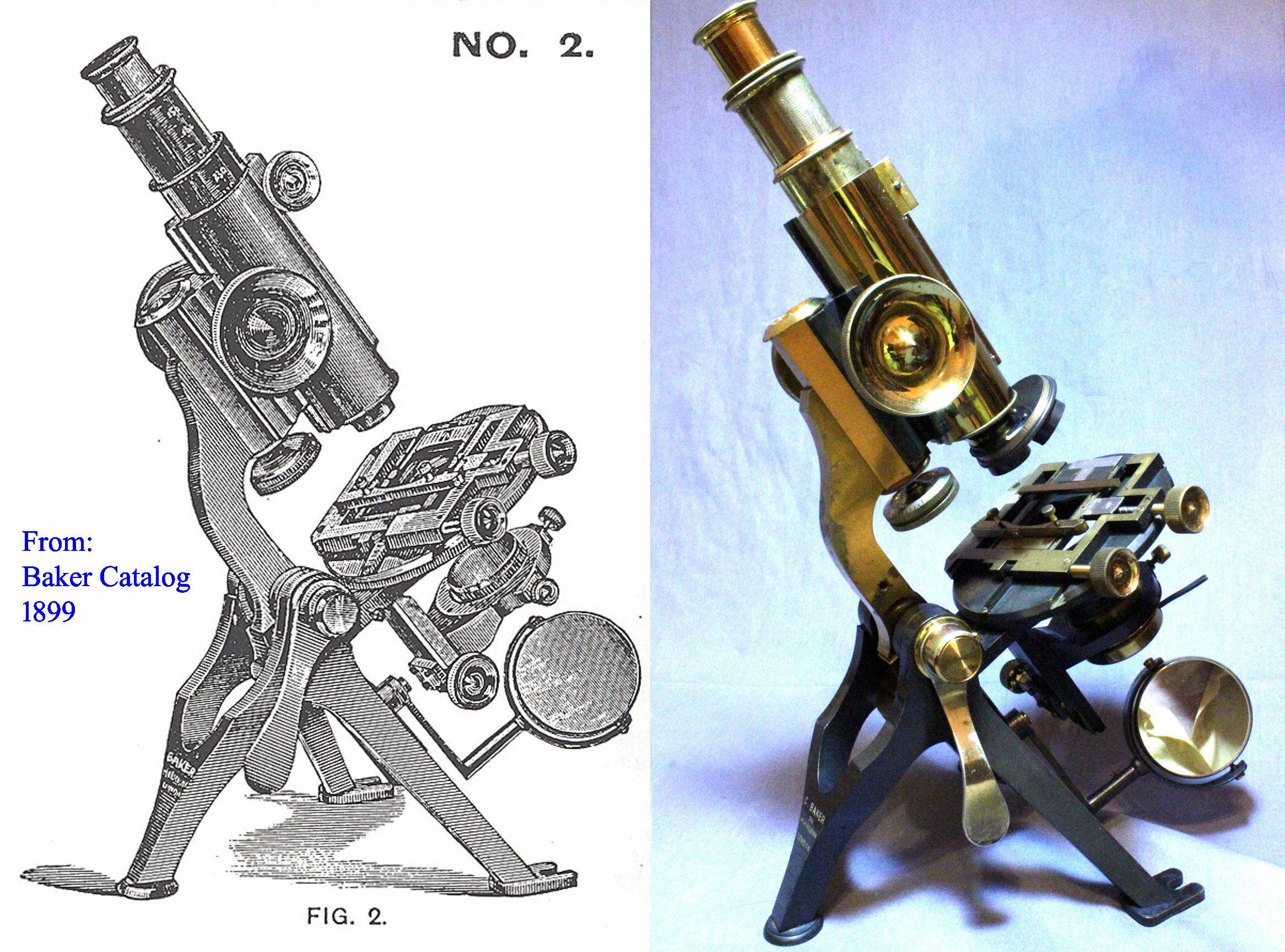 Shown here is a later version of the Nelson-Curties No 2, as as shown in the 1899 catalog. It now included the stage with separate X and Y controls standard, and slotted front feet for anchoring. The rack and pinion rotation to the substage, and the substage fine focus are no longer standard features on the No 2, and not found on the example shown to the left. Rotation for the substage of the No 2 was no longer offered in the catalogs starting in 1898.
Shown here is a later version of the Nelson-Curties No 2, as as shown in the 1899 catalog. It now included the stage with separate X and Y controls standard, and slotted front feet for anchoring. The rack and pinion rotation to the substage, and the substage fine focus are no longer standard features on the No 2, and not found on the example shown to the left. Rotation for the substage of the No 2 was no longer offered in the catalogs starting in 1898.
For most users of the Nelson-Curties model, the number 2, was the usual instrument, and it is a much more commonly seen stand. The Nelson No. 1 is far less common.
Thanks to Dr Joe Zeligs, the author is aware of three extant examples of the larger Nelson model. This includes the example in this collection shown on this page, another one selling at the Arthur Frank collection auction at Sotheby's on March 25, 1986, and another selling on Ebay in July 2007. The example of the Nelson-Curties No 1 from the Frank Collection had a concentric control for the mechanical stage and also had a substage fine focus. The example from Ebay in 2007, had separate controls for the mechanical stage and no substage fine focus and was therefore a Nelson No 1, not a 1a.
Early Nelson-Curties models had round foot pads but later, by 1895, they were often provided, with slotted foot pads in the front to allow securing the stand to a surface, such as would be used for photography.
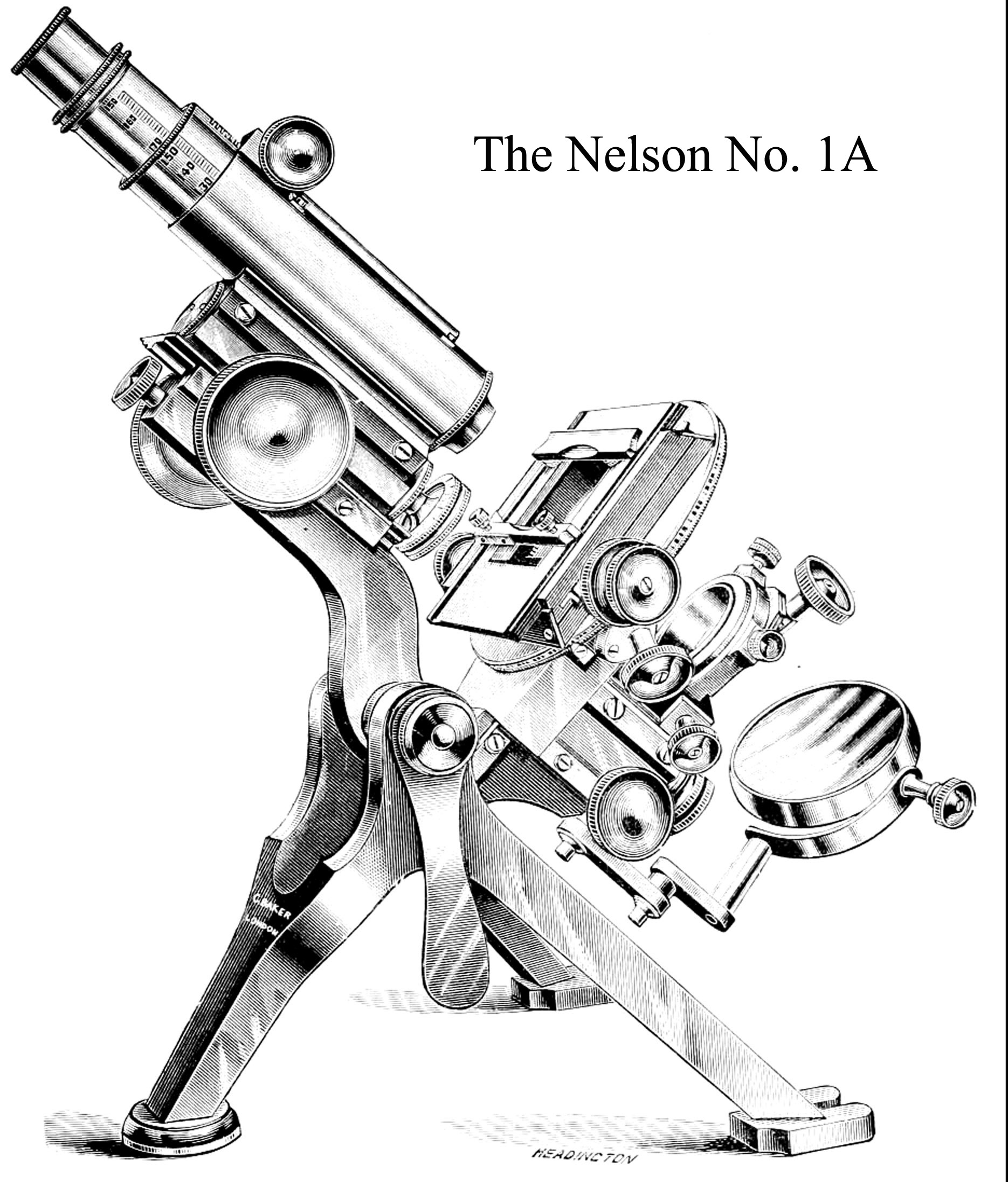 Although the mechanical stage can be rotated manually in both the No. 1 (and 1a), and No. 2, only the No. 1 had the addition of a rack and pinion for this stage rotation. The features of the Nelson 1a, or 1A, as illustrated in the 1901 edition of Carpenter can be seen in the engraving pictured to the left and enlarged here.
Although the mechanical stage can be rotated manually in both the No. 1 (and 1a), and No. 2, only the No. 1 had the addition of a rack and pinion for this stage rotation. The features of the Nelson 1a, or 1A, as illustrated in the 1901 edition of Carpenter can be seen in the engraving pictured to the left and enlarged here.
It is interesting to compare this stand to the competing stands of the time. The triangular tripod support system is similar to the Powell & Lealand as well as the Watson stands like the No 1 Van Huerck and the Royal Models. In fact, at first glance, the stand very much resembles the Watson No 1 'Van Heurck' Models. One difference is the suspension of the Nelson microscope on a stirrup-like fitting. Another is the mechanical stage of the Baker 1a, which more closely resembles that of Powell & Lealand, It should be noted that a bright lacquered finish for the entire instrument was also available at extra cost from both Watson and Baker. But in the 1900 to 1901 catalog, the Baker Nelson No 1 was offered with a bright lacquered brass finish standard. Both the example of the No 1 which sold in 2007 on Ebay, and the example in this collection have an all-bright lacquered finish. Both the Watson and the Baker instruments also have rack and pinion adjustment to the drawtube (as does the Watson Royal). Even the provision of a lever to tighten the inclination joint was also supplied on the Nelson No 1 and Grand Van Heurcks. Like the Royal, and some Van Heurcks, a substage fine-focus was eventually optional for the Nelson-Curties microscope. The mechanical stage of the Nelson models have divisions for the X and Y axis standard, a feature optional on both the Van Heurck's and Royal bu Watson. For a side by side comparison of the Nelson No. 2 and the Royal see here. A side by side comparison of the Nelson No 1a (1A) and the Grand van Heurck is also available. On the other hand, the mechanical stage design of the Baker 1a is very much the same as the Powell & Lealand number 1, with the exception of the location of the X ad Y scales. In fact, as can be seen in a side by side comparison of the stages, it is possible that Charles Perry, who previously worked for P & L, and was by 1904 working for Baker, made or supervised the making of the mechanical stage of the 1a. As noted in the catalog, when equipped with the same mechanical stage as the Nelson No 2, the No 1 was a lot cheaper.
One of the most obvious differences between the high-end Watson microscopes and those of Baker, is of course the underarm location of the fine focusing control, and where present, the location of the substage fine fousing control at the bottom of the substage stem only on the Nelson models. Locating this control in these places puts much less strain on the instrument than the traditional upper position (like on Watson) especially when the main fine focus is controlled by a pulley for photography; in this situation it is much less likely to disturb the stand during focusing than an above-the-arm fine focus. The fine focus in the Baker is also closer to the table and allows the user to rest their hand on the tripod or table when adjusting the fine focus; this is much easier to control and less likely to cause vibration than the higher location on most microscopes of the time. In fact, this idea eventually led to a lower position for most of the controls of modern microscopes. A beneath-the-arm location for the fine focus is also a feature of the American Acme No. 4 and most Krugelstein microscopes, examples of which are also in this collection. It would seem obvious that the Nelson models were E.M. Nelson's (and the Baker company's) response to the Royal and Van Heurck models by Watsons and that the stage of the Nelson 1a, so like the P & L were an attempt to provide the same level of quality ad convenience of these stands into the Baker line. The Nelson No 1 or 'New Microscope' was even slightly larger than the Watson No 1 Van Heurck.
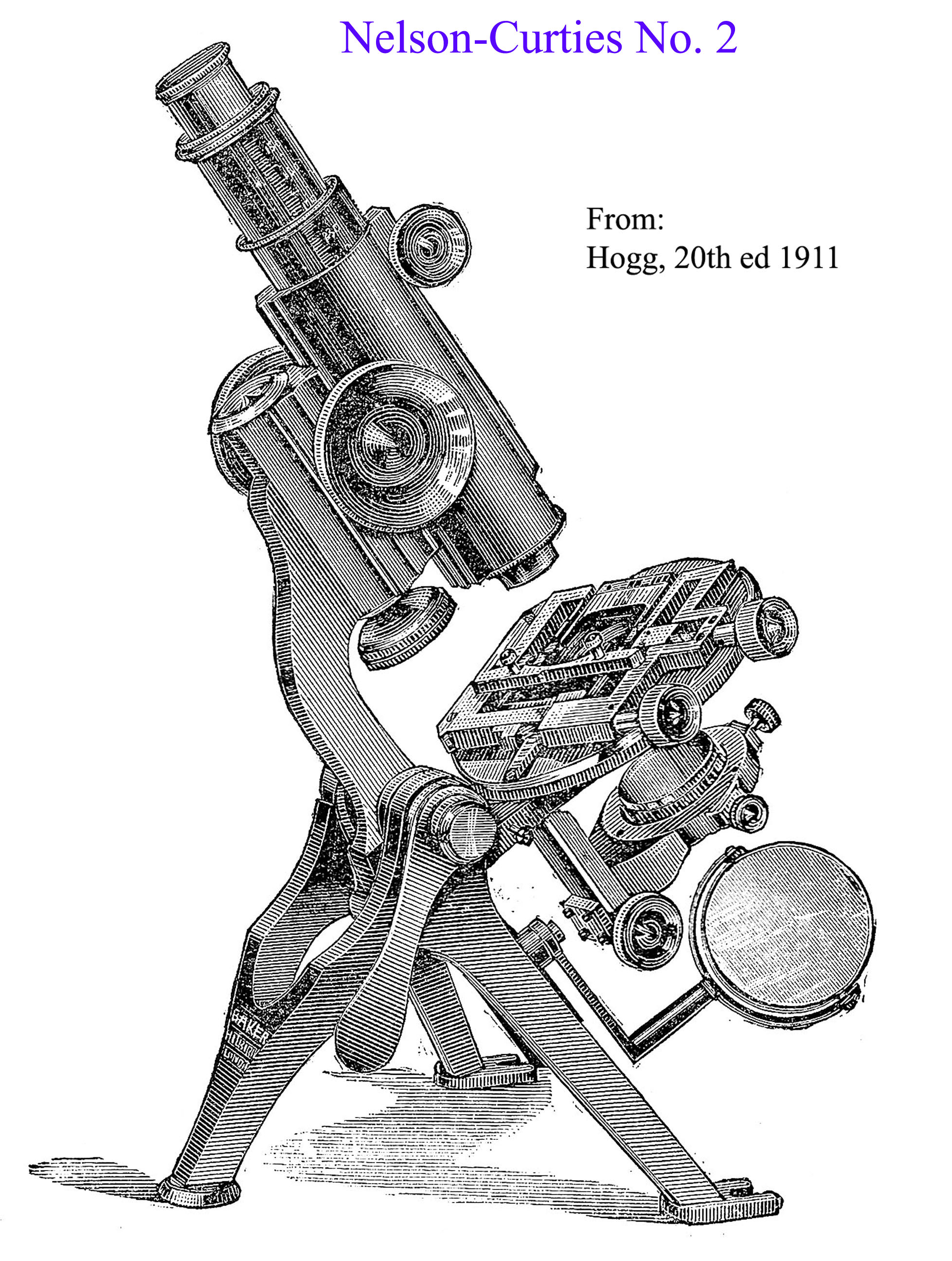 By 1904, when Charles Perry joined them, Baker had become 'agents' for the sale of Powell & Lealand, as announced in the catalog of that year. At that time, the Nelson No 1 and the P & L No 1 were both similar in price and fittings. By 1907, demand for either the Nelson No 1 or P & L No 1 was apparently very low. Although the P & L No 1, was listed, the Nelson-Curties models were no longer listed as available in the Baker catalog. Interestingly, despite their absence from the catalogs at the time, the 1911 edition of Hogg (engraving on left), still pictured and recommended the Nelson No 2 microscope, and the Nelson No. 1 was featured in the Optical Convention Catalog of 1912, though no mention was made of the number 2 in the Optical Convention catalog. Charles Perry, who previously worked for Powell, worked together with Lee Curties producing P &L No 1 stands until the production of the P & L No 1 ceased about 1913. These stands would not bear the Powell & Lealand name until they were personally inspected by Thomas Powell, and only when he was satisfied with the quality of the workmanship would he allow the Powell & Lealand name to be engraved, and his Greeham Road address in Muswell Hill at that time attached. These stands have the Baker name engraved as retailers on the stage. It would seem that during the early years of the 20th century, Baker decided that demand was so low, they would only offer one 'Grand' type microscope, the P & L No 1, in the catalog, as it had a longer track record, and so, by 1907 it was the only microscope of that grandeur listed in the Baker catalog.
By 1904, when Charles Perry joined them, Baker had become 'agents' for the sale of Powell & Lealand, as announced in the catalog of that year. At that time, the Nelson No 1 and the P & L No 1 were both similar in price and fittings. By 1907, demand for either the Nelson No 1 or P & L No 1 was apparently very low. Although the P & L No 1, was listed, the Nelson-Curties models were no longer listed as available in the Baker catalog. Interestingly, despite their absence from the catalogs at the time, the 1911 edition of Hogg (engraving on left), still pictured and recommended the Nelson No 2 microscope, and the Nelson No. 1 was featured in the Optical Convention Catalog of 1912, though no mention was made of the number 2 in the Optical Convention catalog. Charles Perry, who previously worked for Powell, worked together with Lee Curties producing P &L No 1 stands until the production of the P & L No 1 ceased about 1913. These stands would not bear the Powell & Lealand name until they were personally inspected by Thomas Powell, and only when he was satisfied with the quality of the workmanship would he allow the Powell & Lealand name to be engraved, and his Greeham Road address in Muswell Hill at that time attached. These stands have the Baker name engraved as retailers on the stage. It would seem that during the early years of the 20th century, Baker decided that demand was so low, they would only offer one 'Grand' type microscope, the P & L No 1, in the catalog, as it had a longer track record, and so, by 1907 it was the only microscope of that grandeur listed in the Baker catalog.
Thanks to Dr Joe Zeligs I was able to review the pricing of the Nelson No 1 and No 2 about the year 1900. At that time the Nelson No 1 was about 30 £ and the No 2 about 16 £. This is very similar to the price for the Watson Royal, also about 16 £; the Watson Van Heurck exhibition model was a bit more at about 37 £. All these prices are approximate and include a single eyepiece and no objectives. By 1911, the Watson Grand Van Heurck was a little less expensive than the Baker Powell & Lealand. By the middle of the second decade of the 20th century, the Deluxe Grand Microscopes like the P & L No 1, the Nelson No 1a, the Beck Imperial, and the Grand Van Heurck were becoming obsolete, or at least very much less popular, and the practical and less expensive continental microscopes were becoming much more popular. Crouch, Ross, and Collins were no longer making microscopes at all.
For a more complete history of other microscopes associated with E.M. Nelson, and more about the Nelson-Curties No 2, see the Nelson Microscope History page.
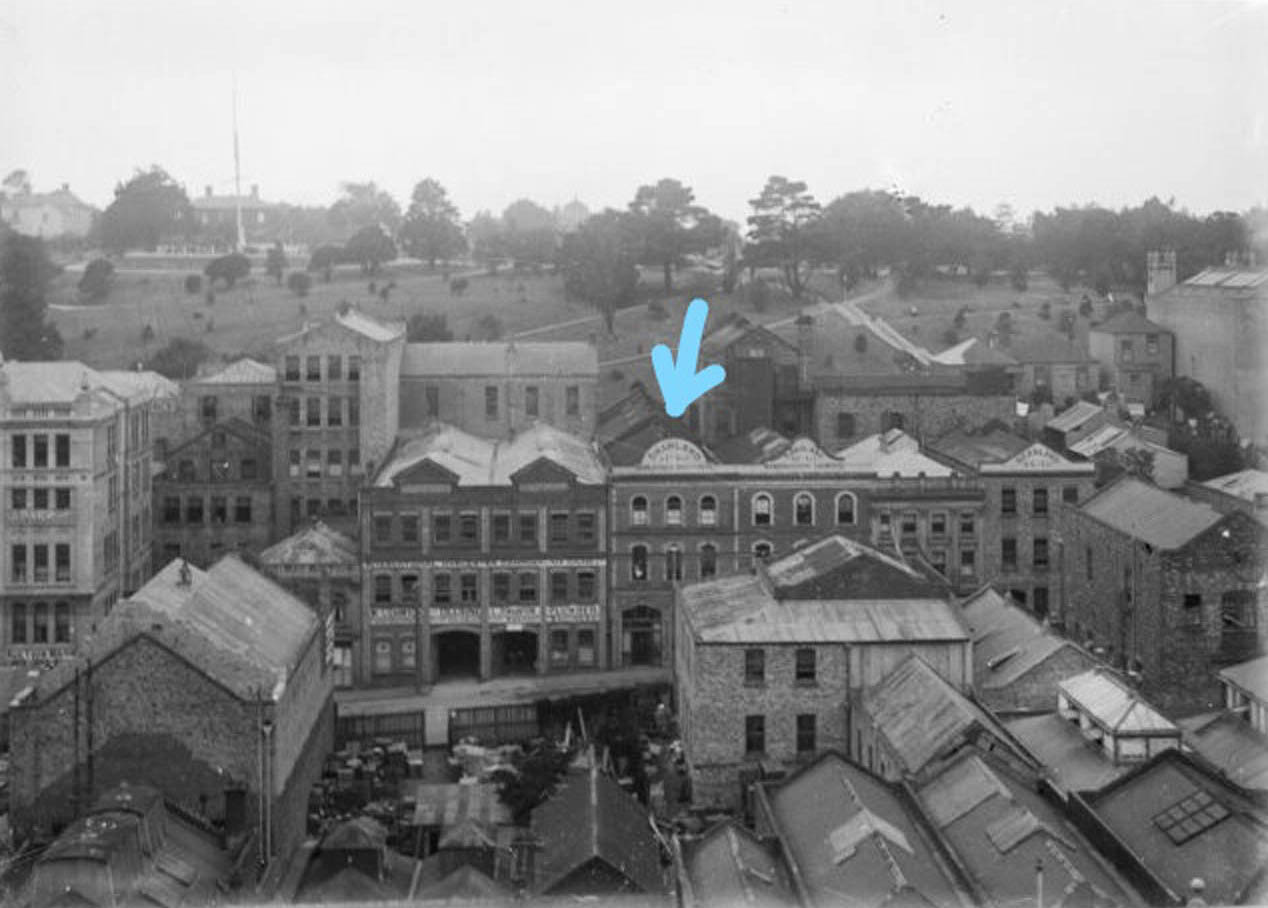 SHARLAND & CO: --BAKER'S AGENTS IN NEW ZEALAND:
SHARLAND & CO: --BAKER'S AGENTS IN NEW ZEALAND:
Sharland & Co were manufacturing/wholesaling chemists and Druggists with branches in Auckland and Wellington in New Zealand. They also retailed medical supplies and equipment. In Auckland, they were located in Lorne street, in the Central Business District. The photograph was taken about 1910, where their premises are marked with an arrow. In the background is Albert Park.
ACKNOWLEDGMENTS:
The author would like to acknowledge the help of Dr Joe Zeligs, who was generous enough to read the draft of this web page and make many very helpful suggestions which I have incorporated into this article. He was also instrumental in providing some of my catalog references and information. I am, as always, very greatful for his friendship, knowledge, and editorial skill in making this website better.
I am also greatful to my good friend Dr Jurriaan de Groot, for the information about, and illustrations of the premises of Sharland & Co, as well as his insight on the reasons that the Nelson No 1 was not as popular as some of the other high class English microscopes and how, in the early 20th century, as Baker attempted to shift production of its highest class microscope to the Powell & Lealand No 1, the highest class English microscopes were already becomming less and less popular.
*In modern times, the Nelson-Curties stands are often called the 'Nelson-Baker' to differentiate them from stands made by other makers and associated with Nelson's name, though Baker himself had little to do with the business by this time and it was Curties who supervised their construction.

 This is a large, heavy, and well made microscope. It is signed on the rear leg of the tripod foot ‘BAKER 244 HIGH HOLBORN LONDON’, with the number 322 stamped into the back of the tripod rear leg. The top draw tube is signed: 'AGENTS, SHARLAND & Co, AUCKLAND'. It stands on a massive tripod base with a large round padded rear leg in the back and two rectangular pads on the front legs with slots towards the front for potential use in fixing the microscope to a surface. The spread of the legs (outside edge to outside edge) is 11 inches(27 3/4 cm)right to left and 9 11/16 inches (23 cm) from each front pad to to the back pad. It is 6 1/2 inches from the table surface to the middle of the axis of inclination. At the top of the tripod base are large trunnions that run through the limb just above the stage. A large clamping lever allows fixing the microscope in any position from vertical to horizontal. There is a round hole on the right and left side of the limb which would accept accessories like a stage forceps or side reflector. Under the stage of the microscope is a large plano-concave mirror supported only on one side; that support is further held on an articulated arm. It comes in its original heavy mahogany fitted case. The microscope itself weights about 19.5 pounds (about 9 KG).
This is a large, heavy, and well made microscope. It is signed on the rear leg of the tripod foot ‘BAKER 244 HIGH HOLBORN LONDON’, with the number 322 stamped into the back of the tripod rear leg. The top draw tube is signed: 'AGENTS, SHARLAND & Co, AUCKLAND'. It stands on a massive tripod base with a large round padded rear leg in the back and two rectangular pads on the front legs with slots towards the front for potential use in fixing the microscope to a surface. The spread of the legs (outside edge to outside edge) is 11 inches(27 3/4 cm)right to left and 9 11/16 inches (23 cm) from each front pad to to the back pad. It is 6 1/2 inches from the table surface to the middle of the axis of inclination. At the top of the tripod base are large trunnions that run through the limb just above the stage. A large clamping lever allows fixing the microscope in any position from vertical to horizontal. There is a round hole on the right and left side of the limb which would accept accessories like a stage forceps or side reflector. Under the stage of the microscope is a large plano-concave mirror supported only on one side; that support is further held on an articulated arm. It comes in its original heavy mahogany fitted case. The microscope itself weights about 19.5 pounds (about 9 KG). 
 The substage collar is on a dovetail mount which slides up and down on the substage support and can be tightened in position with a friction positioning adjustment. This allows customized positioning for various accessories of different lengths.
The substage collar is on a dovetail mount which slides up and down on the substage support and can be tightened in position with a friction positioning adjustment. This allows customized positioning for various accessories of different lengths.  The large mechanical stage is constructed with controls and mechanisms like Powell & Lealand's No 1. It has full X-Y control via concentric knurled knobs to the side on the right, with only a single knob on the left which, like the smaller knob on the right controls the Y-axis. The Nickel scales on the stage indicate the position of the X or Y motion, allowing the user to find a particular spot on a slide in the future. The stage can travel 1 and ⅛ inches in both the X and Y direction. The usable surface of the stage measures 3 and ⅜ inches in the right to left dimension and 4 and ⅜ inches in the front to back dimension. The scales are located differently than on the Powell & Lealand stand. For right-left(X-axis) movement there are two scales, one to the right front and one to the left front of the stage; the left side is used to indicate the slide position when it is moved to the right from the mid-position, the right is used when the stage is moved to the left. The X-axis movement is via a cam and follower mechanism, just like Powell & Lealand stands. The Y-axis movement, again, like P & L, is via rack and pinion. Below is a large bevel gear mechanism to rotate the stage again like Powell & Lealand's. A finely engraved, and relatively thick solid nickel(?) scale plate runs around the top edge of the round part of the stage, with an indicating arrow attached to the rotating stage. The design of this stage, and the angled control for stage rotation, which is permanently engaged, is strikingly similar to the mechanism of the Powell and Lealand No 1 stand of the same era. The design of the rotation plate is also almost identical to the P & L design; one wonders if Charles Perry, formerly of Powell and Lealand, but by then working for Baker, had a lot to do with the design and construction of this stage, as he apparently did when he worked for P & L. Two large slide rests on the top of the stage run in dovetail slots with one having springs to rest against the slide. The stage rotation knob sits at an angle under the stage and has a smaller knob on its center, which acts as a clutch, and can be used to increase the tension on this control or, if tightened completely, lock the stage rotation at an desired location. When the locking knob is loosened,even with the pinion permanently engaged, the stage is easily rotated manually, but will stay in the position it is left in. There are no stage-centering controls, and this is why the stand came with a Beck quick-change nosepiece centering system for objectives.
The large mechanical stage is constructed with controls and mechanisms like Powell & Lealand's No 1. It has full X-Y control via concentric knurled knobs to the side on the right, with only a single knob on the left which, like the smaller knob on the right controls the Y-axis. The Nickel scales on the stage indicate the position of the X or Y motion, allowing the user to find a particular spot on a slide in the future. The stage can travel 1 and ⅛ inches in both the X and Y direction. The usable surface of the stage measures 3 and ⅜ inches in the right to left dimension and 4 and ⅜ inches in the front to back dimension. The scales are located differently than on the Powell & Lealand stand. For right-left(X-axis) movement there are two scales, one to the right front and one to the left front of the stage; the left side is used to indicate the slide position when it is moved to the right from the mid-position, the right is used when the stage is moved to the left. The X-axis movement is via a cam and follower mechanism, just like Powell & Lealand stands. The Y-axis movement, again, like P & L, is via rack and pinion. Below is a large bevel gear mechanism to rotate the stage again like Powell & Lealand's. A finely engraved, and relatively thick solid nickel(?) scale plate runs around the top edge of the round part of the stage, with an indicating arrow attached to the rotating stage. The design of this stage, and the angled control for stage rotation, which is permanently engaged, is strikingly similar to the mechanism of the Powell and Lealand No 1 stand of the same era. The design of the rotation plate is also almost identical to the P & L design; one wonders if Charles Perry, formerly of Powell and Lealand, but by then working for Baker, had a lot to do with the design and construction of this stage, as he apparently did when he worked for P & L. Two large slide rests on the top of the stage run in dovetail slots with one having springs to rest against the slide. The stage rotation knob sits at an angle under the stage and has a smaller knob on its center, which acts as a clutch, and can be used to increase the tension on this control or, if tightened completely, lock the stage rotation at an desired location. When the locking knob is loosened,even with the pinion permanently engaged, the stage is easily rotated manually, but will stay in the position it is left in. There are no stage-centering controls, and this is why the stand came with a Beck quick-change nosepiece centering system for objectives. 
 The body tube has two draw tubes, the top most one is a pull draw tube and the lower one is a geared (or mechanical) draw tube, controlled by rack and pinion; both draw tubes are calibrated. In addition, there is a fixed tube that can be used in place of the top draw tube screwing in from above to the geared draw tube after the other top draw tube collar is removed.
The body tube has two draw tubes, the top most one is a pull draw tube and the lower one is a geared (or mechanical) draw tube, controlled by rack and pinion; both draw tubes are calibrated. In addition, there is a fixed tube that can be used in place of the top draw tube screwing in from above to the geared draw tube after the other top draw tube collar is removed.  In 1888, the first versions of what came to be known as the 'Nelson' Model Microscopes by the Baker company were described. This stand, later to be called the 'Nelson-Curties No. 2'*, or simply the 'Nelson Model', is shown to the left, and was, for a short time, the major 'large' stand for the Baker company. This early version of the No. 2. was referred to in the JRMS as the 'Nelson-Curties (Large Model)'.
It was stated to be specifically designed to work with the new Zeiss Apochromats. That Nelson model was first reported only in written form in the JRMS of 1888 on page 691 and was subsequently first pictured in the JRMS of 1889 page 801, which is the illustration shown to the left.
The microscope, differed from the later number 2, but had several features later to be seen mainly in the No 1. The three most important differences were that the standard features included: (1) a concentrically controlled Mayall-type mechanical stage instead of the two separate controls seen on later models, (2)a substage fine adjustment, and (3)geared rotation to the substage. Later on these features were not standard on the No 2, and eventually, not even standard on the No 1.
In 1888, the first versions of what came to be known as the 'Nelson' Model Microscopes by the Baker company were described. This stand, later to be called the 'Nelson-Curties No. 2'*, or simply the 'Nelson Model', is shown to the left, and was, for a short time, the major 'large' stand for the Baker company. This early version of the No. 2. was referred to in the JRMS as the 'Nelson-Curties (Large Model)'.
It was stated to be specifically designed to work with the new Zeiss Apochromats. That Nelson model was first reported only in written form in the JRMS of 1888 on page 691 and was subsequently first pictured in the JRMS of 1889 page 801, which is the illustration shown to the left.
The microscope, differed from the later number 2, but had several features later to be seen mainly in the No 1. The three most important differences were that the standard features included: (1) a concentrically controlled Mayall-type mechanical stage instead of the two separate controls seen on later models, (2)a substage fine adjustment, and (3)geared rotation to the substage. Later on these features were not standard on the No 2, and eventually, not even standard on the No 1.  An example of an early form of the No 2, slightly later than the original, featuring the geared rotation and fine focus to the substage, is shown to the left, but by the time it was made, circa 1895, the mechanical stage controls were not concentric; this form of mechanical stage would be the standard type of stage for Nelson No 2 for the next two decades. As to the substage, still with geared rotation on the model to the left, this feature for substage rotation was also eliminated for the No 2 by 1898, when it was not even listed as an option.
An example of an early form of the No 2, slightly later than the original, featuring the geared rotation and fine focus to the substage, is shown to the left, but by the time it was made, circa 1895, the mechanical stage controls were not concentric; this form of mechanical stage would be the standard type of stage for Nelson No 2 for the next two decades. As to the substage, still with geared rotation on the model to the left, this feature for substage rotation was also eliminated for the No 2 by 1898, when it was not even listed as an option.  By 1892 a larger version, the 'New Microscope' or 'Nelson Model No. 1' a larger version of the Nelson-Curties design, became the 'No. 1' Stand, and the original 'Large' Nelson-Curties became the 'No 2'. The No 1 stand was usually shown in illustrations to have a rack and pinion rotation to both the stage and substage. The mirror support was double jointed, and the substage fine focus was standard. Most importantly, this was a much thicker, larger, and heavier stand. For the reader's interest, see the Nelson No 1 and No 2 Microscope Comparison page. Unlike earlier versions, now called the No 2's, the limb of the new No. 1 angles inward towards the stage, away from the inclination joint, whereas in the No 2, the limb continues straight from the inclination joint and at its top end, curves inward to meet the optical tube. The image to the left shows the earlier version of the model featured above at the top of this web page.
By 1892 a larger version, the 'New Microscope' or 'Nelson Model No. 1' a larger version of the Nelson-Curties design, became the 'No. 1' Stand, and the original 'Large' Nelson-Curties became the 'No 2'. The No 1 stand was usually shown in illustrations to have a rack and pinion rotation to both the stage and substage. The mirror support was double jointed, and the substage fine focus was standard. Most importantly, this was a much thicker, larger, and heavier stand. For the reader's interest, see the Nelson No 1 and No 2 Microscope Comparison page. Unlike earlier versions, now called the No 2's, the limb of the new No. 1 angles inward towards the stage, away from the inclination joint, whereas in the No 2, the limb continues straight from the inclination joint and at its top end, curves inward to meet the optical tube. The image to the left shows the earlier version of the model featured above at the top of this web page.  Shown here is a later version of the Nelson-Curties No 2, as as shown in the 1899 catalog. It now included the stage with separate X and Y controls standard, and slotted front feet for anchoring. The rack and pinion rotation to the substage, and the substage fine focus are no longer standard features on the No 2, and not found on the example shown to the left. Rotation for the substage of the No 2 was no longer offered in the catalogs starting in 1898.
Shown here is a later version of the Nelson-Curties No 2, as as shown in the 1899 catalog. It now included the stage with separate X and Y controls standard, and slotted front feet for anchoring. The rack and pinion rotation to the substage, and the substage fine focus are no longer standard features on the No 2, and not found on the example shown to the left. Rotation for the substage of the No 2 was no longer offered in the catalogs starting in 1898.  Although the mechanical stage can be rotated manually in both the No. 1 (and 1a), and No. 2, only the No. 1 had the addition of a rack and pinion for this stage rotation. The features of the Nelson 1a, or 1A, as illustrated in the 1901 edition of Carpenter can be seen in the engraving pictured to the left and enlarged here.
Although the mechanical stage can be rotated manually in both the No. 1 (and 1a), and No. 2, only the No. 1 had the addition of a rack and pinion for this stage rotation. The features of the Nelson 1a, or 1A, as illustrated in the 1901 edition of Carpenter can be seen in the engraving pictured to the left and enlarged here.
 By 1904, when Charles Perry joined them, Baker had become 'agents' for the sale of Powell & Lealand, as announced in the catalog of that year. At that time, the Nelson No 1 and the P & L No 1 were both similar in price and fittings. By 1907, demand for either the Nelson No 1 or P & L No 1 was apparently very low. Although the P & L No 1, was listed, the Nelson-Curties models were no longer listed as available in the Baker catalog. Interestingly, despite their absence from the catalogs at the time, the 1911 edition of Hogg (engraving on left), still pictured and recommended the Nelson No 2 microscope, and the Nelson No. 1 was featured in the Optical Convention Catalog of 1912, though no mention was made of the number 2 in the Optical Convention catalog. Charles Perry, who previously worked for Powell, worked together with Lee Curties producing P &L No 1 stands until the production of the P & L No 1 ceased about 1913. These stands would not bear the Powell & Lealand name until they were personally inspected by Thomas Powell, and only when he was satisfied with the quality of the workmanship would he allow the Powell & Lealand name to be engraved, and his Greeham Road address in Muswell Hill at that time attached. These stands have the Baker name engraved as retailers on the stage. It would seem that during the early years of the 20th century, Baker decided that demand was so low, they would only offer one 'Grand' type microscope, the P & L No 1, in the catalog, as it had a longer track record, and so, by 1907 it was the only microscope of that grandeur listed in the Baker catalog.
By 1904, when Charles Perry joined them, Baker had become 'agents' for the sale of Powell & Lealand, as announced in the catalog of that year. At that time, the Nelson No 1 and the P & L No 1 were both similar in price and fittings. By 1907, demand for either the Nelson No 1 or P & L No 1 was apparently very low. Although the P & L No 1, was listed, the Nelson-Curties models were no longer listed as available in the Baker catalog. Interestingly, despite their absence from the catalogs at the time, the 1911 edition of Hogg (engraving on left), still pictured and recommended the Nelson No 2 microscope, and the Nelson No. 1 was featured in the Optical Convention Catalog of 1912, though no mention was made of the number 2 in the Optical Convention catalog. Charles Perry, who previously worked for Powell, worked together with Lee Curties producing P &L No 1 stands until the production of the P & L No 1 ceased about 1913. These stands would not bear the Powell & Lealand name until they were personally inspected by Thomas Powell, and only when he was satisfied with the quality of the workmanship would he allow the Powell & Lealand name to be engraved, and his Greeham Road address in Muswell Hill at that time attached. These stands have the Baker name engraved as retailers on the stage. It would seem that during the early years of the 20th century, Baker decided that demand was so low, they would only offer one 'Grand' type microscope, the P & L No 1, in the catalog, as it had a longer track record, and so, by 1907 it was the only microscope of that grandeur listed in the Baker catalog.
 SHARLAND & CO: --BAKER'S AGENTS IN NEW ZEALAND:
SHARLAND & CO: --BAKER'S AGENTS IN NEW ZEALAND: